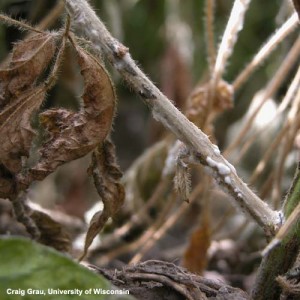
White mold is caused by the fungus Sclerotinia sclerotiorum. The fungus is easily recognized by the presence of fluffy white mycelium (the vegetative body of the fungus) that is the source of the name white mold.
White mold of soybean, also called Sclerotinia stem rot, was discovered in Central Illinois in 1948. Although white mold became a chronic problem in Michigan, Minnesota, and Wisconsin by the 1970’s, the remainder of the North Central states experienced no problems with the disease.
By 1992, however, white mold was prevalent throughout the other North Central states. Because of its expanded geographic range and more frequent occurrence, white mold has progressed from a sporadic disease to an annual threat to soybean production throughout the upper North Central region.
Reasons for the sudden increase of white mold in the region are not fully understood, but could be related to changes in cultural practices and/or changes in the genetic base of current soybean varieties or the white mold pathogen.


